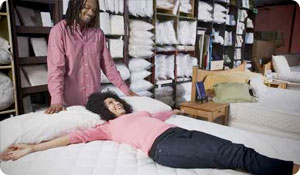
The question is no longer a simple, "soft or firm?", but do you want to include"muscle-recovery properties" or "thermal-regulation technology" when you buy your next mattress? Whatever criteria you choose, comfort rules!
Even the best mattresses lose support with time. If your mattress is pretty good quality, but more than eight years old, the National Sleep Foundation says it's probably time to start thinking about a new one.
Comfort and Support
The goal of good sleep posture is to maintain the natural curve of your spine, which is in the shape of an "S" for those with healthy posture. To achieve or maintain good sleep posture, avoid mattresses that are too soft. While a mattress should be supportive, firmer is not always better. Consider comfort as well as firmness for a healthy night's sleep.
Size it Up
The number and size of people who will be sleeping on a mattress determines the size mattress you should buy. A mattress should be at least six inches longer than the tallest person sleeping on it, according to Utah State University Extension author and home furnishings specialist, Dr. Leona Hawks. A mattress should also be wide enough that sleepers can position their hands behind their heads with elbows sticking out and without touching a partner.
Put it to the Test
You can try out different types of mattresses at any mattress store, and you should. If more than one person is going to be sleeping on the mattress, make sure it feels comfortable to everyone. Test out innerspring mattresses for firm support in the center of the bed, and foam varieties if you want a mattress that conforms a little better to your body. Best news yet: if you're buying a top-of-the-line mattress, most stores will let you take it home to try it out and, if you're not happy, exchange it for a new mattress within a certain number of days.
Hot, Hot Hot!
Here's some news that won't surprise everyone: Men get hotter in bed than women. The theory, which rests mostly with some mattress manufacturers who have options to sell, was reported in a 2009 Wall Street Journal article about men and their mattresses. While that may be true for some younger men and women, however, menopausal women have a different story to tell. The cooling, air-flow technology used in some temperature-regulating mattresses might also offer some relief to women who suffer from night sweats while they are transitioning to menopause.
Cool air temperature is always best for sleeping, but that doesn't mean you should feel cold in bed. If you need warming up, throw an extra blanket or a mattress-size heating pad on the bed, rather than increase the temperature in the room.
Why Conform?
Some mattresses are designed to conform to your body in ways that hold your neck, shoulders, spine, back, hips and legs in place, while at the same time relieving pressure on those areas. A sleep test is the only way to know if this type of mattress provides a proper balance of support and comfort for your body.
National Sleep Foundation. "Buying the Right Mattress for You." 14 Oct 2008. Web. 8 Sept 2010.
http://www.sleepfoundation.org/alert/buying-the-right-mattress-you
Hawks, Leona. "Selecting a Comfortable Mattress." Utah State University Extension 1987. Web. 8 Sept 2010.
http://extension.usu.edu/files/publications/factsheet/hi_07.pdf
Smith, Ray. "Pimp My Bed: The Male Sleep Lair." The Wall Street Journal Online. 23 Sept 2009. Web. 8 Sept. 2010.
http://online.wsj.com/article/SB10001424052970204488304574429070364650290.html?mod=googlenews_wsj





